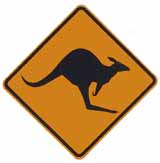 We’re rapidly approaching the semicentennial anniversary of the classic and yet-to-be-replicated study ‘Curiosity in Zoo Animals’ (Behaviour, Volume 26, Issue 1). Investigators Stephen E. Glickman and Richard W. Sroges* performed an extensive series of experiments with kangaroos and more than 100 other species of zoo animals, to see how curious they were. The team presented various objects (a pair of wooden blocks, two lengths of steel chain, two pieces of wooden dowel, two lengths of rubber tubing and a white crumpled paper ball) which were scaled (roughly) according to the size of the animal under test. The animals’ visual inspections of, and other interactions with, the objects were recorded (unless they were purely accidental) and scored accordingly.
We’re rapidly approaching the semicentennial anniversary of the classic and yet-to-be-replicated study ‘Curiosity in Zoo Animals’ (Behaviour, Volume 26, Issue 1). Investigators Stephen E. Glickman and Richard W. Sroges* performed an extensive series of experiments with kangaroos and more than 100 other species of zoo animals, to see how curious they were. The team presented various objects (a pair of wooden blocks, two lengths of steel chain, two pieces of wooden dowel, two lengths of rubber tubing and a white crumpled paper ball) which were scaled (roughly) according to the size of the animal under test. The animals’ visual inspections of, and other interactions with, the objects were recorded (unless they were purely accidental) and scored accordingly.
“The kangaroos were not notably reactive. No kangaroo obtained a score of greater than 6 to any objects, with the exception of the paper. The oldest male kangaroo began to devour this object and the test was discontinued after two minutes of steady chewing. The young male also chewed steadily upon the paper, although the test was completed as he made no attempts to swallow the material. Both female kangaroos showed no reaction to the paper, aside from an initial sniff in the adult subject. The youngest kangaroo (of unknown sex) grew progressively more upset as testing proceeded and we were unable to complete the last test (crumpled paper) as the animal was leaping blindly about the stall.”
Of the other species, primates were by far the most curious, whereas reptiles, as a whole, were largely indifferent – with the exception of one Orinoco crocodile “who lunged at, pushed and bit all of the test stimuli.”
A full copy of the paper may be found here.
*note: Improbable has not been able to find any online record of Richard W. Sroges, except, possibly, ‘Development of Edible Mouth Coolants’. (paperback, 1967)